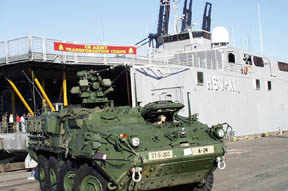The U.S. Army conducted a friendly invasion of the Port of Tacoma yesterday morning, demonstrating the capabilities of the HSV-X1 Joint Venture, a 313-foot catamaran the military is testing as a troop and equipment transport.
The distinctive looking ship, carrying soldiers and vehicles from a Fort Lewis-based Stryker Brigade Combat Team, arrived at Terminal 7 at around 8 a.m., demonstrating its turn-on-a-dime maneuverability by sidling up to the dock.
From there, soldiers deployed a ramp and unloaded the Armys new Stryker interim armored vehicles, Humvees and other equipment.
A total of 28 vehicles were downloaded from the ship, according to Chief Warrant Officer 3 Rebecca Brashears, including 14 Stryker vehicles, with most of the rest consisting of Humvees and a few other support vehicles.
The Stryker brigade was returning from California, after having taken part in Millennium Challenge 2002, a joint military experiment bringing together 13,500 participants at 17 computer simulation sites and nine live sites across the United States.
In October, the Army leased the Joint Venture, a passenger ferry modified for the military, from Australian shipbuilder Incat Tasmania Pty Ltd.
The Army is currently assessing the capabilities of the ship in anticipation of purchasing several ships of this type in the future.
Soldiers have been testing the vessel since April, including in the waters of the Middle East where they performed various missions in support of Operation Enduring Freedom.
Were very happy to be up here in the Pacific Northwest, said Maj. Gen. Robert Dail, commandant of the U.S. Army Transportation School and commander, Fort Eustis, Va.
Dail touted the vessels many capabilities and said it would greatly improve the Armys logistical missions when it comes to supporting forces ashore.
Though it would most certainly be deployed in combat situations, Dail pointed out ships like the Joint Venture are part of a transportation force and are not considered offensive combat platforms.
That role is reserved for the U.S. Navy, he said.
The aluminum, wave-piercing catamaran is capable of traveling at speeds in excess of 40 knots (46 mph).
It can carry 850 short tons and accommodate 363 personnel, including crew.
It doesnt require a lot to load this vessel, Dail noted. It doesnt require a lot to unload this vessel.
The Joint Venture is approximately four times faster than vessels currently in the Armys watercraft fleet.
Incredibly, the ship requires a minimum water depth of only 15 feet in which to operate.
In practical terms, that increases the number of ports accessible to the ship by a factor of five.
Thats an awesome thought, Dail said. We establish warfare on our terms, not the ememys.
The testing of the Joint Venture during the year-long lease period is part of the Armys transformation goal of being able to deploy a combat-ready brigade anywhere in the world within 96 hours, a division in 120 hours and five divisions within 30 days.
Were very excited about what were doing, Dail said.
On board the Joint Venture, Port Commissioner Jack Fabulich and ship’s skipper, Chief Warrant Officer 4 William Davis, exchanged plaques commemorating the ships arrival at the Port of Tacoma.
The relationship between the Pacific Northwest and the military in general, and the Army specifically, is secure.
Dail said there was a possibility a vessel like the Joint Venture would be stationed in or near Tacoma.
Following the equipment unload and on-board ceremony, press and other invited guests were invited to ride on the ship during a brief journey around the Puget Sound, at which time tours of the ship were given.
Regulations kept the ships speed to about 15 knots, Army officials stated.
Perhaps it was all for the best, as throughout the morning some soldiers could be heard complaining of seasickness, the result of traveling at over 40 knots in the open ocean during rough seas on the way to Tacoma.
The Army is leasing the Joint Venture at a cost of $10 million, and plans to lease another such ship for $12 million.
The final cost per vessel will be approximately $85 million, with the Army tentatively planning on purchasing six of the watercraft.
The Navy – including the Marine Corps – and the Coast Guard are also testing the vessel.





